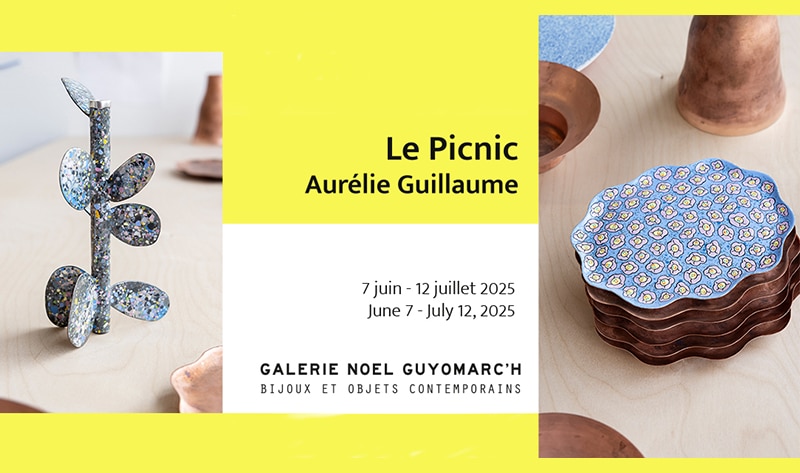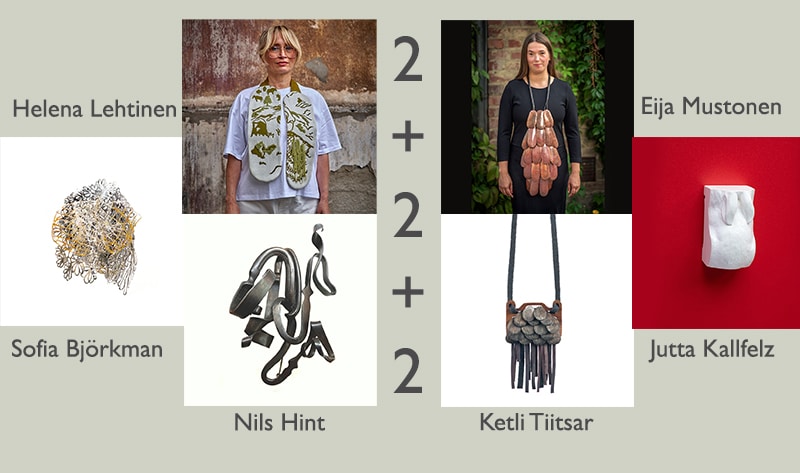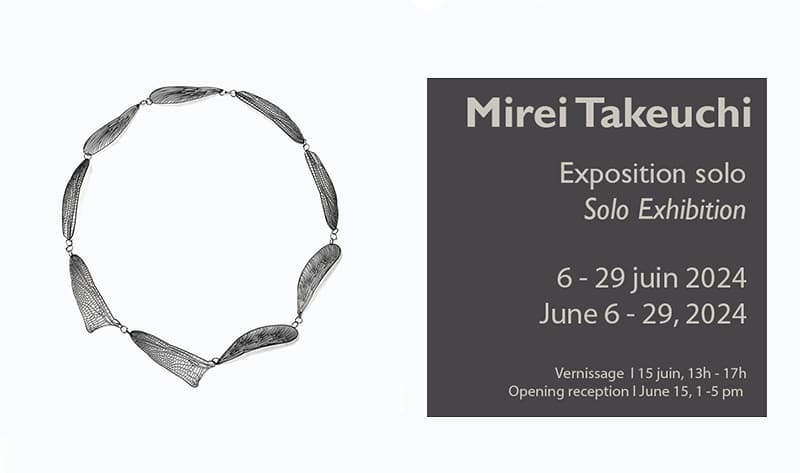
Exhibition Animal Vegetable Mineral – Curator Melanie Egan
Animal Vegetable Mineral
Curated by Melanie Egan
January 28 – February 25 2023
Visit Animal, Vegetable, Mineral to see the art work
Premiered last fall in Toronto at Harbourfront Centre, this exhibition Animal, Vegetable, Mineral, curated by Melanie Egan, is part of Nordic Spotlights, a series of unique experiences highlighting contemporary northern arts and culture. This exhibition brings together artists from Canada, Iceland, Finland, Norway, Sápmi, Sweden and Denmark.
Jewellery is one of the oldest cultural identifiers. Over 120,000 years ago, prehistoric humans engaged in “aesthetic curiosity” (Smith 1974), adorning their bodies with shell necklaces. This human activity has endured for millennia.
Contemporary jewellery is a term widely used since the 1960s and much like contemporary art; it expands our view of society, culture, the world-at-large and ourselves. It differentiates itself from other craft practices because it has never been limited to one material – it can be animal, vegetable or mineral thus opening up many possibilities. Jewellery is significant for its direct associations with bodies, its ability to convey ideas at an intimate level and its movement through space and time.
Running counter to widely held ideas about what constitutes “fine jewellery” and what represents value, these artists embrace debris and detritus; the desecrated bones of a political decision; the overlooked and undervalued; the hidden consequences; the reclaimed, restored and memorialized. Through the catalyst of contemporary jewellery, artists use materials redolent with meaning and the body as site to confront issues of identity, social critique, and political change.
Melanie Egan has over 35 years of experience in the field of craft and design. She is Director of Craft & Design at Harbourfront Centre; Canada’s foremost artist-in-residency devoted to ceramics, glass, textiles, jewellery and design. She is a curator, organizes symposia, lectures, writes, mentors and advocates for craft & design in Canada and internationally.
Invited artists:
Bridget Catchpole (British Columbia), Annette Dam (Denmark), Helga Mogensen (Iceland), Alex Kinsley (Ontario), Tania Larsson (Gwich’in, NWT), Helena Johansson Lindell (Sweden), Anna Rikkinen (Finland), Máret Ánne Sara (Sámpi/Norway) + matt lambert (USA/Sweden), Catherine Sheedy (Québec), and Despo Sophocleous (Nova Scotia)
Animal Vegetable Mineral – Artists’ biographies
Bridget Catchpole.
Bridget Catchpole lives on the unceded territory of the Kómoks First Nation of Hornby Island, BC. She studied Fine Art (BFA 1998) at Concordia University, Montreal, QC and Jewellery Art and Design (Dip 1993) at Vancouver Community College, Vancouver, BC.
Bridget Catchpole is the recipient of multiple grants from Canada Council for the Arts and BC Arts Council. She has exhibited her work nationally and internationally for over 20 years. In April 2022, she was presenting Still The Ocean Sounds The Same at Galerie Noel Guyomarc’h.
Bridget Catchpole is a Canadian visual artist with a practice in contemporary jewellery and sculpture. Her work is a material exploration of the worth and waste of plastic, a reflection of anthropogenic climate change, recovery, and transformation. Since 2004, she has altered discarded plastics in her work to produce one-of-a-kind pieces and, more recently, to create sculptural “Wall Jewellery” forms.
Her recent work, entitled “Stages of Healing,” resembles geological core samples. Using a palette evocative of healing bruises, the work nods to a future where plastics no longer encroach on the natural environment but have been buried within the geological strata layers from the Anthropocene. In this future, these geologically digested plastics are considered a collectable curiosity, like mineral curios from an incomprehensibly reckless era. Bridget lives and works on Hornby Island, BC, Canada.
Annette Dam
Annette Dam was educated at the Oslo National Academy of the Arts in Norway in 1999. Her works have been exhibited in Denmark and internationally. In 2015 she was selected for the World Craft Council’s European Prize for Applied Arts in Belgium. Dam received the prestigious Skt. Loye Award from the Kjøbenhavns Guldsmedelaug.
“My jewellery is created in a sensual and narrative universe, combining elements of seriousness and a sense of humour. It is considered through a loving and critical perspective aiming for communicative art jewellery. I seek to create works where the artistic, conceptual and handcraft meet, and through an investigative practice. This process serves as an active contributor to the design and final expression. Sometimes it feels like a riddle that I struggle to solve: to visualize and materialize abstract thoughts into wearable jewellery pieces. It becomes an investigative ping pong between the ideas, material compositions and my craft skills. But cracking the riddle is where a lot of my drive lies.”
Helga Mogensen
Helga R. Mogensen is a jewellery artist that graduated from Edinburgh College of Art, Scotland, in 2007. Since then, she has been participating in exhibitions in Iceland and abroad. Mogensen uses a wide range of materials such as silver, copper, steel, driftwood and fish skin when creating her jewellery pieces. A place that inspires her work is up north in Iceland, where she goes every summer with her family. The closeness to nature and the remote location makes this place her favourite when seeking inspiration. All her pieces are one-off pieces, and no two are the same. Mogensen lives and works in Reykjavik, Iceland.
Alex Kinsley Vey
Alex Kinsley Vey is from Hamilton, Ontario, where he received jewellery training from his parents. Moving to Toronto in 2010, he studied jewellery at George Brown College, receiving an Advanced Diploma in Jewellery Arts in 2013. Vey has shown work in Canada, Europe and the United States. He has been a member of Craft Ontario since 2012, Klimt02 since 2017 and is one of the co-founders of MetalAid and a Harbourfront Centre Craft and Design Artist-in-Residence from 2015–2019. He is currently a member at Jewel Envy in Toronto’s west end. Vey is a sessional instructor at OCAD University and has previously taught at both George Brown College and NSCAD University.
“There are three deaths. The first is when the body ceases to function. The second is when the body is consigned to the grave. The third is that moment, sometime in the future, when your name is spoken for the last time.” – David M. Eagleman
About his new body of work;
« The Third Death came from a personal place of regret, never getting to know my Opa before his passing in 2012. This series of photographic brooches is an attempt to extend his Third Death. His name is Oscar “Rene” Franz Ludwig Vey. From his childhood in Nurnberg during the Second World War, to his journey to Canada and his work in the metalworker’s union movement in London, Ontario. These fragments of his life are all that are left behind.
I etch these photos from paper onto steel, a material that unites us both (him as a caster and moulder, me growing up in the shadow of the steel mills of my hometown) and lasts much longer than the paper and acetate originals. However, everything decays; the rust gives us a glimpse into that future. Entropy is a constant. Nothing lasts forever.»
Tania Larsson
Tania Larsson uses materials that come from the Canadian Arctic. She operates a jewellery studio in Yellowknife where she designs and makes hand-fabricated jewellery.
“My work is guided by the seasons: caribou hides are thinner in the spring while thicker moose hides are best found in the fall. When I tan my hide, I know their quality and how easy it will be to sew on them depending on how much I work it.” Larsson learned to bead from her mother who taught her how to make her own beading loom. With the help of family and friends, she began creating jewellery as a teenager. “I always wanted to wear jewellery that represented my Gwich’in culture, and it was really hard to find that,” she says.
After studying arts at the Institute of American Indian Arts, she apprenticed with Kiowa jeweler Keri Ataumbi where she fell further in love with jewellery and adornment. Her passion for beadwork, meanwhile, was rekindled after completing an artist leadership program at the Smithsonian Institution’s National Museum of the American Indian in 2015. “I looked at all the Gwich’in items they had in their collection. These items that belonged to my nation were the most beautiful pieces of art I had seen. During this visit, I fell in love with the colour palette of vintage and antique beads. Their colours and qualities were so different from today’s bead production.”
Helena Johansson Lindell
Helena Johansson Lindell is an artist and jewellery maker based in Stockholm, Sweden. She studied at Konstfack University College of Arts, Crafts and Design in Stockholm and KHIO, the Oslo National Academy of the Arts in Norway. Her solo work has been shown in the Nordic Regions, Asia, the United States and Brazil. Exhibitions have been held at the International Craft Fair and It’s Green at Galerie Handwerk in Munich, Germany, as well as the 6th European Triennial of Contemporary Jewellery which toured in Belgium, Sweden and France.
Helena Johansson Lindell works with hierarchical structures and preconceptions within the field of contemporary jewellery. She embraces materials and methods that, from a societal perspective, are considered of low status. Her aim is for her craft to infuse a sense of permission, that everything is allowed without judgment, a topical and meaningful subject.
– Swedish contemporary craft has undergone a strong development throughout the 2000s and holds an exceptionally high international level. Nevertheless, craft is rarely seen or featured in larger contexts or in political initiatives. Few countries can match our Swedish line-up of multifaceted artists working within the field – we have a golden opportunity to show them off,. says Maj Sandell, Director at Konsthantverkscentrum.
Anna Rikkinen
Finnish visual and jewellery artist Anna Rikkinen lives and works in Lahti, Finland. Raised in an aesthetical village milieu and educated in the decorative arts, she creates works that draw influence from sources including 17th-18th-century Dutch portraiture and African apparel, as well as historical fashion and architectural and domestic ornaments. Rikkinen’s work ranges from wearable sculptures to body-related objects and installations. She tries to evoke the body by playing with the language of volume and space. For Harbourfront Centre, Rikkinen shows large-scale jewellery sculptures made of wooden objects, like daily utensils and souvenirs. She reclaims unwanted materials, reconfiguring found wooden kitchenware from bland and practical things into mysterious clusters. Starting from characteristics of the ready-made, Rikkinen creates tactile artifacts that reveal the absurdity of our actions and greed.
Máret Ánne Sara
Máret Ánne Sara is an artist and author. She is from an indigenous Sámi reindeer herding family in Kautokeino, Northern Norway, and she currently lives and works in her hometown.
Sara is the initiator and founding member of the Sámi artist collective Dáiddadállu. She has published two novels and was nominated for the Nordic Council’s Children’s and Young Literature Prize in 2014 for her debut book Ilmmid gaskkas.
Sara has exhibited visual art since 2003 and often deals with political and social issues, from a Sami and reindeer-sámi social perspective. Her extensive art project Pile o’Sápmi was presented at Documenta 14 in Kassel in 2017 and later acquired by the National museum of Norway. In 2022 she is one of three Sámi artist who transformed the Nordic pavilion to a historic first Sámi Pavilion at the 59th Venice Biennale.
matt lambert
matt lambert is a non-binary, trans, multidisciplinary collaborator and co-conspirator working towards equity, inclusion and reparation. Their practice is based on polydisciplinamory, entangling making, writing, curating, collaborating and performing. lambert is currently a Ph.D. candidate in Craft at KonstfackUniversity of Art, Craft and Design in Stockholm, Sweden, and has published, curated and exhibited internationally. They have a MA in Critical Craft Theory from Warren Wilson College and an MFA in Metalsmithing from Cranbrook Academy of Art.
lambert is interested in the relationship of body, object, and place and the movements or constellations that form between these points. In inhabiting these queer or liminal spaces, these interactions gain their strength as a force yet to be explored for its potential as a terroristic act to westernized and colonial institutions. lambert collaborates with multi-media artists of a vast array of disciplines to reconfigure the current cultural systems of queerness and body politics while challenging the boundaries of craft.
Catherine Sheedy
Trained in jewellery and metalsmithing during her three-year diploma at the École de joaillerie de Quebec, Catherine Sheedy continued her studies in Visual Arts at the Université Laval, where she was awarded her MFA in 2007. Her interest in contemporary jewellery led her to participate in experimental workshops and artist-in-residence programs. Sheedy has presented her work in several exhibitions and publications in Canada, the United States, France, Spain, the Netherlands and the United Kingdom. She has been the recipient of grants from the Quebec Art Council and the Canada Art Council. She has won prizes, including the Metal Arts Guild of Canada Steel Trophy Award 2013 and the 2017 Jean-Marie Gauvreau Award, the highest distinction from the Quebec Craft Council. Sheedy’s work his represented by Noel Guyomarc’h Gallery in Montreal and are part of the collections of the Musée des métiers d’art du Québec (MUMAQ) and the Musée des beaux-arts de Montréal (MBAM).
Despo Sophocleous
Born in Nova Scotia, Despo Sophocleous holds a BFA in Jewellery Design and Metalsmithing from the Nova Scotia College of Art and Design University. In 2015 she completed her graduate studies at the Munich Academy of Fine Arts. Her work has been exhibited nationally and internationally and found in both private and public collections. Sophocleous is the recipient of several awards, including the Deutscher Akademischer Austausch Dienst Graduate Scholarship (DAAD), and the Herbert Hofmann Prize prize. She has received support for her work from Arts Nova Scotia and the Canada Council for the Arts.
Movement, mapping and architecture are central to the work of Despo Sophocleous. Her necklaces are a visual articulation of the vocabulary of place, of being in a certain place at a certain time as well as the transformative effects of movement and change and the stillness that comes with stopping. Linked by rope like marionettes, the sawn pieces retain their draft marks – lines mapping her making process. There is unity and symmetry to the composition of the forms, falling gently and rhythmically like sand passing through an hourglass.





